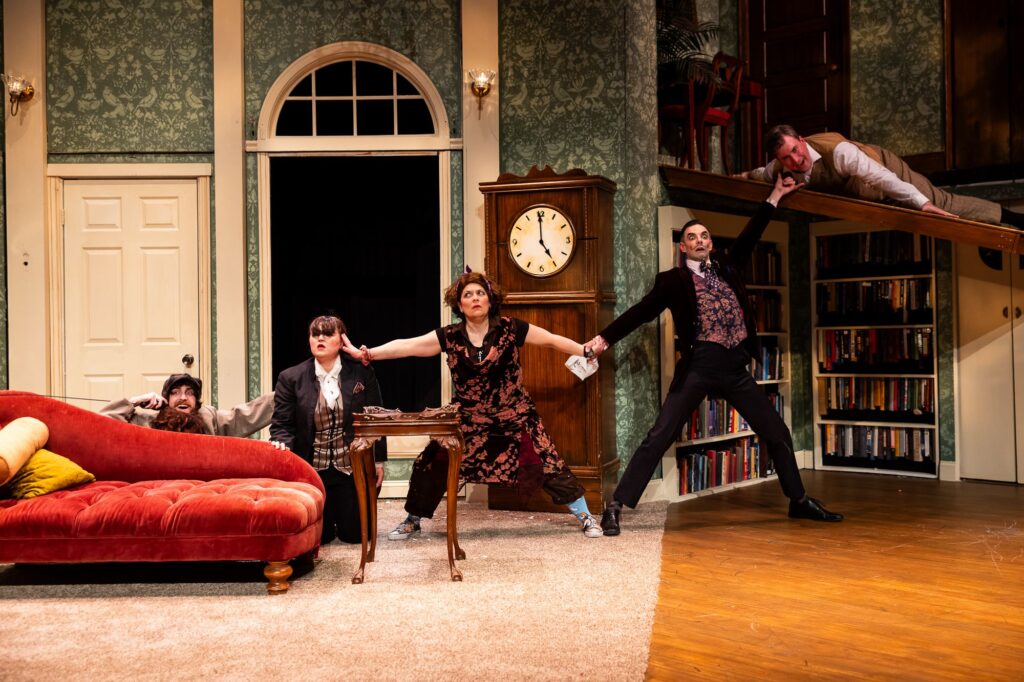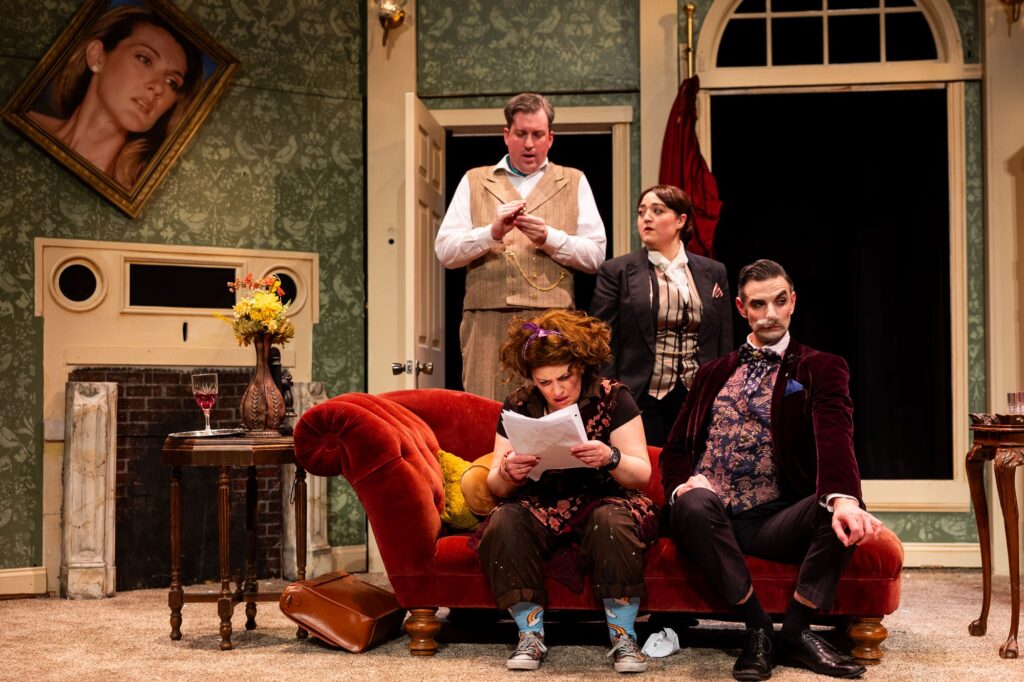
The cast. Photo via Greater Boston Stage Company.
Presented by Greater Boston Stage Company
Written by Henry Lewis, Henry Shields, and Jonathan Sayer
Director – Tyler Rosati
Original Scenic Design – Peter Colao
Scenic Design – Danielle Ibrahim
Lighting Design – Katie Whittemore
Costume Design – E. Rosser
Sound Design – James Cannon
Properties Master – David Allen Prescott
Intimacy/Violence Design – Samantha Richert
Production Stage – Manager Meghan Ward
Fight Captain – Sarah Morin
March 28 – April 19, 2025
Greater Boston Stage Company
395 Main Street
Stoneham, MA 02180
Critique by Craig Idlebrook
2 hours with a brief intermission
Some comic violence. May be too intense for young viewers.
STONEHAM, Mass. — Regular theatergoers quickly understand that live performance is a tightrope act, and the mind can wander to what can go wrong during lulls on stage. That may be why theatrical disasters are such fertile ground for stage comedy. To pull off such a play requires mastering the (sometimes nominal) source material and then acting at acting badly. Things can quickly get complicated, making the farce on stage sometimes something of a miracle to pull off.
The cast of the Greater Boston Stage Company’s The Play That Goes Wrong largely succeeds in this difficult task, creating chaos on stage that set the audience howling with laughter. The script provides a target-rich environment for comedy, and the energetic and committed cast capitalize on most of the opportunities provided.
This play follows the hapless Cornley Polytechnic Drama Society in their quest to stage The Murder at Haversham Manor, a boilerplate 1920s whodunnit reminiscent. Things quickly go wrong when a key set piece falls down, and the play’s victim Jonathan (Stewart Evan Smith) resurrects when his fellow actors keep step on his hand. It’s all downhill from the opening pages, much to the audience’s delight, as roughly half the cast end up suffering head injuries at one point or another and require “stagehand” stand-ins. By the time the actors realize they are in a plot point time loop due to a forgotten line, the audience can fully buy into the slow death the characters are experiencing on stage.
Anyone who has sat through a family member’s middle school play knows that a production’s inherent terribleness will only hold your attention for so long. Successful terrible-play-within-a-plays must mitigate our ability to zone out when confronted with such disasters. Shakespeare kept the wooden play-within-a-play action short at the end of A Midsummer Night’s Dream, while Michael Frayn gave us three distinctive perspectives to view backstage drama with Noises Off. For this play, playwrights Henry Lewis, Henry Shields, and Jonathan Sayer instead opt for an endurance race for their characters, but in doing so they rely on a cast creating enough good will for the audience to root for them.
To do this requires clear beats on stage to fully understand the racing thoughts and motivations of the characters. Sometimes, this isn’t always possible with this production. While director Tyler Rosati succeeds in keeping up the script’s frenetic pace, he is sometimes less successful in playing traffic cop. As such, some comedic beats get muddled, lost, or overemphasized. Another hurdle is that some of the cast fully commit to the chestnut device of the wooden actor delivering wooden lines, but even Kevin Kline could only pull this off in the film version of Midsummer for a minute or two before the performance grated.
Luckily, there are just enough slowed-down moments on stage to help us connect with the human element of the visual disaster. Paul Melendy (E

The cast. Photo via Greater Boston Stage Company.
ditor’s comment: Moist) has near flawless timing in his delivery as Chris, the nominal director of the play; through his portrayal we can see through Chris’s bravado to see the character’s fear. Sarah Morin also gives a sneaky great performance as Denise, who portrays a character designed to blend into the background until she horribly, horribly cannot; Denise’s vulnerability in these moments are vital to the heart of the play. Also notable is Jeff Mahoney as Trevor, a stage hand who is phoning it in until he is thrust into the action; Trevor takes to this new task as if he were former coach Bill Belichick unhurriedly trying to figure out live theater on the fly.
The combination of comedic disaster and true earnestness on stage helps the audience root for the home cast, against all odds. And when the doomed play finally ends, we feel a mix of relief and regret.

Leave a Reply
You must be logged in to post a comment.